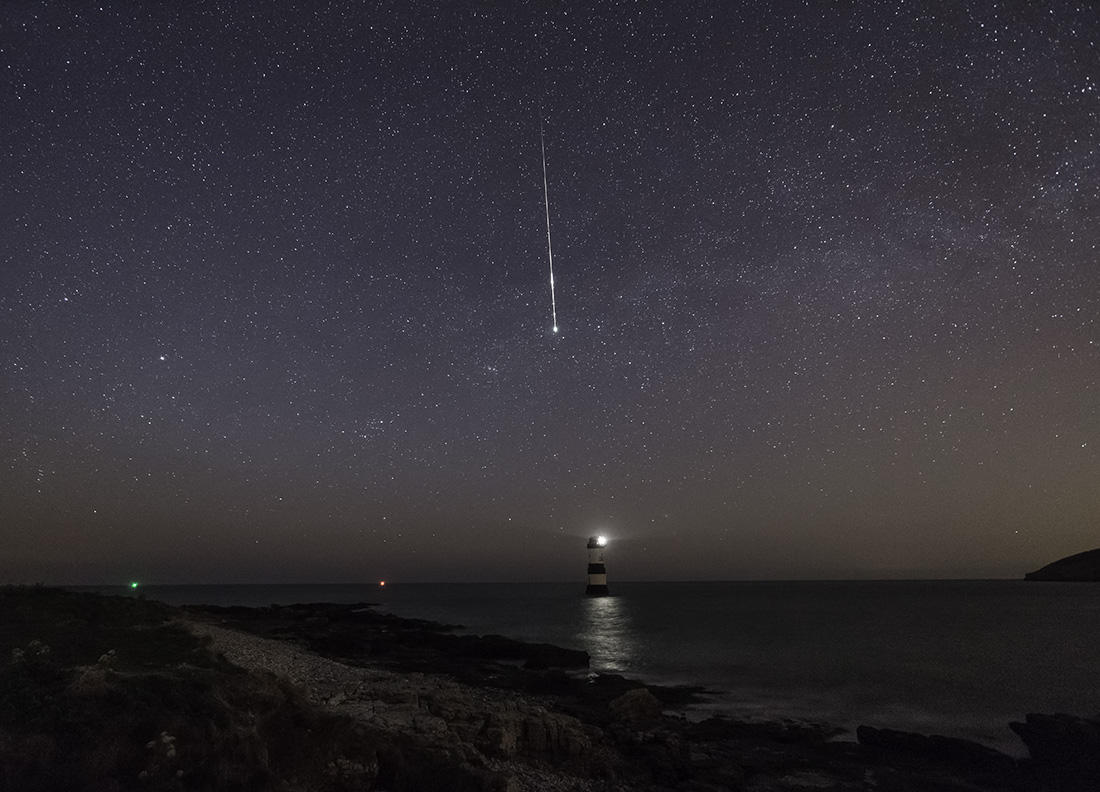
‘To Catch A Falling Star…’ – Penmon, Anglesey, UK – A meteor captured at 1:16am on Apr 20th. 2014 @ Kris Williams
It is not a Lyrid otherwise it should be originating from the radiant near Vega at the top-right of the shot.

Examples of Lyrid activity seen on April 23, from 40 N latitude, just before dawn while facing north.
After three months of low rates, April ushers in two major showers and a temporary upswing in meteor activity. The first of these showers is the Lyrids, which are active from April 16 through the 25th. Activity for this shower is low away from the peak night which expected to occur on April 22/23. Peak rates are predicted to occur near 4:30 Universal Time on April 23, which corresponds to 0030 EDT and 2130 PDT (on the 22nd). This timing is better for the eastern portion of North America as the Lyrid radiant will lie higher in the sky. Rates seen from the western half should not be that much lower so all of North America is well placed to view this display. Average ZHR’s are eighteen for this shower so visual rates in excess of ten per hour should be seen from North America on the morning of the 23rd.
On the night of maximum activity the Lyrid radiant is actually located in eastern Hercules, seven degrees southwest of the brilliant star Vega (Alpha Lyrae). This area of the sky lies below the horizon during the early evening hours. It attains a decent elevation between midnight and 0100, depending on your latitude. It is best situated high in a dark sky just before the start of morning twilight. While the Lyrids are not the strongest shower, it is notable that shower members will occasionally reach fireball intensity.
On the night of maximum activity the moon will be at its waxing crescent phase and will have set by the time the radiant reaches a decent altitude. Lunar conditions could not be much better for this display. Observers in the Southern Hemisphere will see very little Lyrid activity as the radiant will be located low in the northern sky. All Lyrid meteors will trace back to the radiant area in eastern Hercules. There will be other showers and random activity visible during this period so not all meteors will be members of the Lyrid shower. Lyrid meteors will appear to travel swiftly through the sky unless they are seen near the radiant or near the horizon. Lyrids seen there will move more slowly as they are moving towards you (if seen near the radiant) or away from you (if seen near the horizon).
The Lyrids are particles from Comet Thatcher (C/1861 G1). This comet has an orbital period of 415 years and the last time it was a perihelion was back in 1861. This shower has produced several notable outbursts. These occurred in the years 1803, 1849, 1850, 1884, 1922, 1945, and 1982. The 1803 event seems to the strongest as rates exceeded 500 Lyrids per hour at maximum. The 1982 event was seen from eastern USA where rates were estimated near 100 per hour at maximum. I witnessed the final portions of this outburst as I drove out to dark sky site. Lyrid meteors were seen shooting upward from the northeastern horizon. Once I arrived at my site the outburst was over and very little activity was seen the remainder of the night. The next possible outburst for this shower is predicted to occur in 2040 and 2041.
 American Meteor Society
American Meteor Society
Can’t wait, hopefully no clouds. I’m ready for a good one!!!